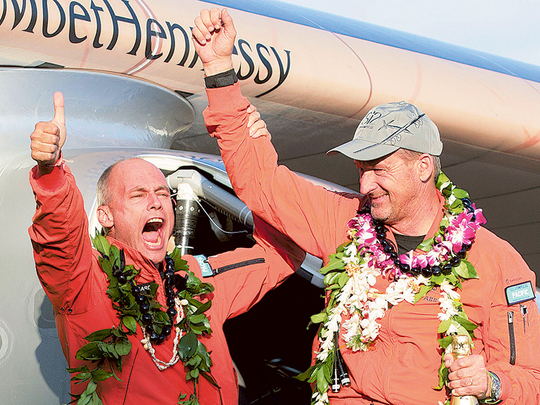
Abu Dhabi: After making history by flying non-stop for five days and nights, Solar Impulse 2 is gearing up for its next challenge — a flight from Hawaii to Phoenix, USA and onwards to New York, Europe and back to Abu Dhabi.
The aircraft is expected to clock an estimated 20,000 kilometres over the next five legs of the flight, heading back to Abu Dhabi, from where it began the historic journey in March. An estimate 390 hours of flight time will be required to complete the remaining legs.
Solar Impulse 2 not only created an aviation record by completing its 177-hour journey from Nagoya, Japan to Hawaii on Friday morning (8pm UAE time), but also achieved a historic first for renewable energy.
Bertrand Piccard, Chairman of Solar Impulse and the second pilot of the team, said that the flight proved that “nobody now can say that renewable energy cannot do the impossible”. He added, “Flying day and night, five days five nights … What André Borschberg has done today is the most extraordinary flight you make.”
He added: “Would you imagine that André’s flight was longer than all the other single-seater aeroplane flights who had fuel? That’s an incredible message. Now you fly longer with no fuel than with fuel, so what André Borschberg has done is not only a historic first for aviation but a historic first for renewable energy.”
However, the challenges don’t stop with the completion of this journey, as Solar Impulse 2 prepares for its next leg, flying from Hawaii to Phoenix, USA, for 100 hours straight, with Picard at the helm.
André Borschberg, CEO of Solar Impulse, flew non-stop for over four days, recording the longest ever solo flight in the history of aviation, all without using a single drop of fuel.
The flight had its challenges before being able to start this leg of its journey, with the aircraft being grounded in Japan for over three weeks, and having to go through two delays due to unfavourable weather conditions over the Pacific.
Remarkably, once the aircraft was in the air, the flight did not run into any major problems, even with all the challenges and risks it faced while in the air. During the journey André Borschberg would only take occasional 20-minute sleeping breaks.
On arrival Piccard, alongside members of the Solar Impulse team, enthusiastically greeted Borschberg.
Speaking to the media after landing, Borschberg said he felt good and was “disappointed” that the flight was over. “Interestingly not really [feeling exhausted], I’m also astonished [by this] but we got so much support during the flight from so many people, I got messages all the time in the cockpit, it gave me so much energy, there was no way to stop or to fail.”
“When I was planning to come [for the landing] I was disappointed that the flight was already over”.
Explaining how he coped with the long flight, he said, “I do a lot of yoga and meditation … It gives a lot of benefits, one benefit is you become an observer about what you do. I take a distance and I understand the way I react and it helps me change my reaction to become less stressed.”
Borschberg spoke on some of the challenges he faced during the flight, including one on the day of the landing, “There are sometimes special moments like this morning, for example, we were surprised to get into clouds where we didn’t expect, so you have moments where you have to get all your resources together to be able to move forward,” he explained.
The Solar Impulse 2 began its historic journey across the world on March 9 when it flew out of Abu Dhabi. The aircraft is expected to complete its journey by landing back in Abu Dhabi some time in late July or early August.
The aircraft’s wingspan is longer than that of a jumbo jet, but it weighs only 2.3 tonnes — about the same as a car.
— With inputs by Shafaat Shahbandari, Staff Reporter












